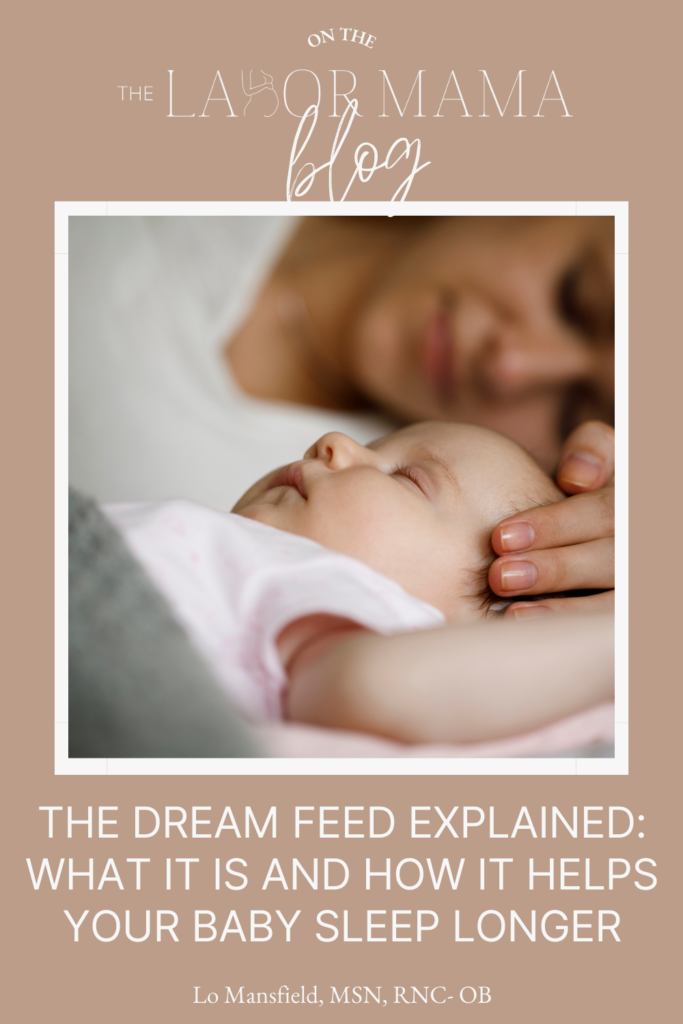If you’re navigating the world of baby sleep, you’re probably exhausted. You also have probably heard about dream feeds and night feeds. And while they might seem similar, they’re actually quite different. Dream feeds are a specific tool that some parents use to help their baby (and themselves!) get a longer stretch of sleep during the night – at the same time. So, what exactly is a dream feed, and how can it help you and your baby sleep better? Let’s get into it!
We’ll be chatting about:
- What is a dream feed?
- Why would you dream feed?
- Example of dream feeding
- When to start dream feeding
- How to dream feed
- Does dream feeding really work?
But before we dive into all things dream feeds– Who is The Labor Mama and Why Am I Here?
Hey friend! I’m Lo – also known around here and social media as The Labor Mama. I’ve spent my nursing career in labor, delivery, and postpartum, have birthed 4 of my own babies, have labored thousands of mamas at the bedside, have taught thousands of students online, and have even delivered a few speedy little babies with my bare hands (oops).
Here at TLM, I offer online classes about birth, postpartum, newborn care, and breastfeeding to empower you the way everyone should be. The education + support I offer gives you experience, evidence, and empathy; you’re getting all of my years of “clinical” RN knowledge, honestly combined with my real experiences as a mama, nurse, and CLC. These are not your average hospital classes (those won’t do it, I promise), and honestly, birth, postpartum, and breastfeeding don’t follow a textbook or protocol anyway. You need to know so much more than that!
If you want to connect with me further, head to Instagram. There are hundreds of thousands of us over there learning together daily.
A note: This post may include affiliate links. This means if you make a purchase after clicking a link, I will earn a small commission (thank you)! Rest assured, this comes at no additional cost to you. You can read TLM’s full disclosure here.
Now, back to dream feeds!
What is a Dream Feed?
A dream feed is an extra feeding you give your baby while they are still asleep. It usually happens a couple of hours after their bedtime and right before you go to bed. Unlike a night feed, where your baby wakes up on their own, you’re the one gently rousing your baby during a dream feed. The goal is to fill their tummy again before you hit the sack, giving both of you a long, uninterrupted stretch of sleep.
Here’s how it works: After you put your baby down for the night, wait about three-four hours (or until you’re about to go to bed yourself). Then, gently wake your baby and offer the breast or bottle. The idea is that they’ll stay mostly asleep, eat enough to fill up, and then drift right back off into a peaceful slumber. Fingers crossed, right?!
Why Would You Dream Feed?
There are a few reasons why dream feeding might be worth a try:
1. More Sleep for Everyone
The main reason parents try dream feeds is to help shift their baby’s longest sleep stretch to overlap with their own. Dream feeding doesn’t make your baby sleep longer overall, but it can help line up their sleep patterns with yours, so you both get a longer stretch of uninterrupted sleep.
2. Maintaining Milk Supply
For breastfeeding moms, a dream feed can be a helpful way to keep up your milk supply. If your baby is starting to sleep longer stretches at night, some might notice a drop in supply. This extra feeding gives your body another opportunity to produce milk, which can be especially useful if you’re worried about maintaining supply.
That being said, not every breastfeeding mom needs to dream feed. Many babies naturally take in more milk during the day as they start sleeping longer at night, and your body will adjust to that change in supply and demand. But if you notice your supply dipping, a dream feed might help give it a little boost.
3. Bonding Opportunity
If your baby takes a bottle, dream feeding can be a sweet opportunity for another caregiver—like dad or a partner—to get involved. While you catch some extra z’s or pump, they can enjoy some quiet bonding time with the baby. Some families really cherish these little moments of connection during dream feeds (this is a huge reason I’ve always loved the dream feed in my house).
Example of How a Dream Feed Could Work
Take a peek at the two schedules below. This baby has their longest sleep stretch from 7 pm – 1 am…the hope with adding in a dream feed is to “push” that 5 hour stretch back, so it coincides with the hours that you are in bed sleeping too.
Without a dream feed:
- Baby’s bedtime: 7:00 pm
- First wake: 1:00 am
- Second wake: 4:00 am
- Wake-up: 7:00 am
With a dream feed:
- Baby’s bedtime: 7:00 pm
- Dream feed: 10:00 pm (before you go to bed)
- Night wake: 4:00 am
- Wake-up: 7:00 am
This example shows how a dream feed might push your baby’s longer sleep stretch to overlap with your sleep. Every baby is different, so results can vary!
When to Start Dream Feeding
You might be wondering, “When is the right time to try a dream feed?” The short answer is: It depends! Typically, you’ll want to wait until your baby is consistently giving you one long stretch of sleep. For most babies, this happens around 2-3 months of age (or later). Dream feeding probably isn’t necessary in the first month when babies need to be eating every 2-3 hours anyway.
If your baby is a bit older right now and already consolidating sleep, you might not even need to introduce a dream feed. It’s really about what works best for you and your little one!
How to Dream Feed
When you’re ready to give dream feeding a try, here’s how to do it:
- Wait about three hours after your baby’s bedtime to make sure they’re hungry enough to eat.
- Gently wake your baby, but try not to fully rouse them. Keep the lights low, noise to a minimum, and avoid too much stimulation.
- Offer the breast or bottle while they’re still groggy. If possible, keep them swaddled and comfortable.
- Skip the diaper change unless it’s absolutely necessary to minimize the disruption.
- Let them drift back to sleep, and you do the same!
If your baby is tough to wake or just isn’t interested in eating, it might be a sign that dream feeding isn’t the best fit for you both right now.
Does Dream Feeding Really Work?
Dream feeding isn’t a one-size-fits-all solution. It works wonders for some families, while others find it doesn’t make much of a difference. Here are a few signs that it might be time to drop the dream feed:
- Your baby wakes up fully during the feed and struggles to go back to sleep.
- Your baby refuses to eat during the dream feed.
- The dream feed disrupts your baby’s natural sleep pattern, causing more frequent wakings.
As with anything baby-related, consistency is key. If you decide to try dream feeding, give it a week or so to see if it’s making a difference. If not, it’s okay to let it go! It’s also okay to come back to the dream feed and try it again a month or so later and see if you have more success.
To wrap up this post all about dream feeds…
Dream feeding can be a helpful tool for parents looking to maximize their sleep while helping their baby develop longer sleep stretches at night. Every baby is different, so while dream feeding works for some, it may not be necessary or effective for others. Give it a try, see how it fits into your routine, and adjust as needed. Sweet dreams (for both of you)!
Looking for more when it comes to caring for + feeding your sweet little babe? I’ve got you! Inside of my 4th Trimester course bundle, you’ll get both Beyond the Birth and The Breastfeeding Blueprint. This bundle will give you access to so much knowledge about your 4th trimester body, the new baby transition, feeding your baby, breastfeeding and pumping, comfort and sleep, and so much more!
Now I want to know, have you tried a dream feed? Did it work for you and your baby? I would love to hear in the comments! -xx, Lo
Loved this blog post? Here’s some others you’ll probably like:
- The Best Lactation Cookies & Energy Bites For Milk Supply
- 12 Breastfeeding Myths (From A Postpartum RN)
- Breastfeeding: A Healthy Milk Supply From Day One
More resources (and freebies!) for you to take a peek at:
- Comprehensive Birth Plan and Birth Priorities templates
- A complete Third Trimester Checklist
- The RN + mama of 3 Ultimate Packing List
- The Labor Mama online birthing classes for every family






